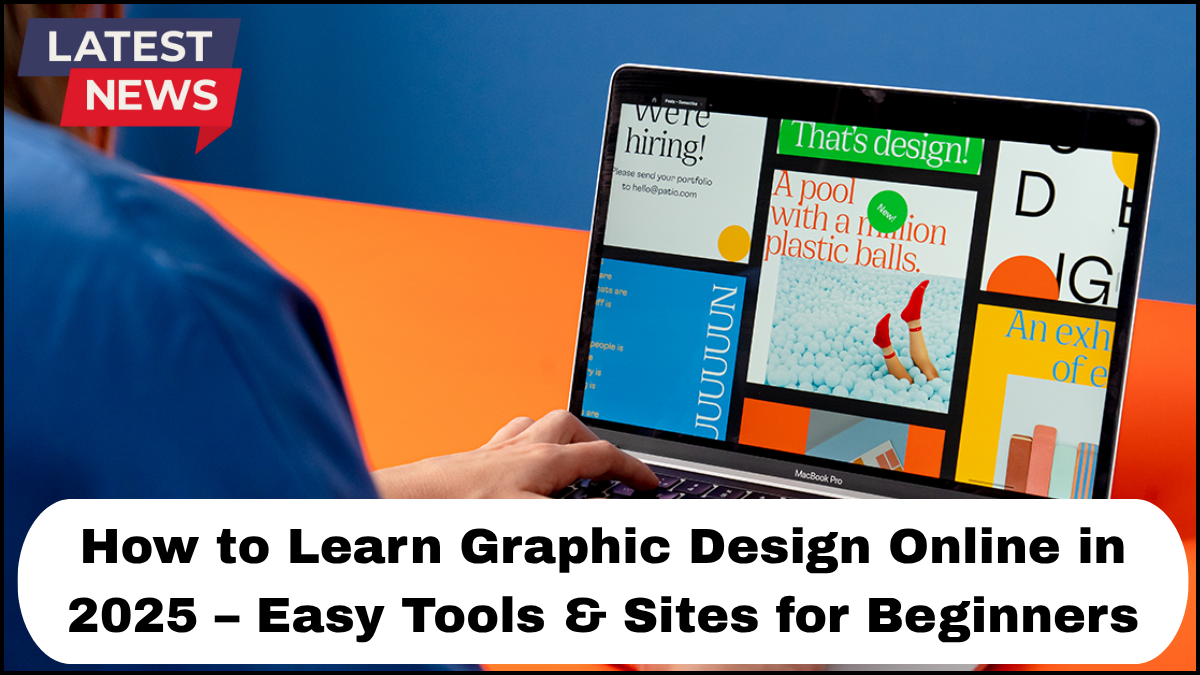Learning graphic design online in 2025 is easier and more accessible than ever. With powerful tools, free resources, and interactive platforms tailored for beginners, you can start building your online graphic design skills without a design degree or expensive software.

Why Learn Graphic Design Online in 2025?
Graphic design is now a core skill across many industries. From digital marketing and content creation to UI/UX and branding, the demand for skilled designers is growing fast. Whether you want to freelance, launch a creative side hustle, or boost your career, learning design online lets you move at your own pace, from anywhere.
What You Need to Start
You don’t need fancy equipment to get started. A laptop or tablet, stable internet connection, and a willingness to practice consistently are your essentials. Most beginner-friendly tools run on the cloud, meaning your device doesn’t need to be high-end.
Top Tools & Platforms for Beginners
1. Canva
Perfect for absolute beginners. Canva offers drag-and-drop features, pre-designed templates, and a vast library of elements. It’s ideal for creating social media graphics, presentations, posters, and more.
Why use it?
- User-friendly interface
- Free version with solid features
- Great for practicing layout, typography, and visual balance
2. Adobe Express
Adobe’s entry-level platform lets users create visually stunning content quickly. It bridges the gap between simple tools like Canva and more complex software like Photoshop.
Why use it?
- Free for basic use
- High-quality templates
- Integrates well with Adobe Creative Cloud
3. Figma
Originally built for UI/UX design, Figma is now used for everything from mobile app mockups to social posts. It’s collaborative, cloud-based, and great for learning modern design workflows.
Why use it?
- Real-time collaboration
- Ideal for interface and product design
- Free tier available
4. Photopea
A browser-based Photoshop alternative. If you want to learn raster design (photo editing, complex layering), Photopea mimics Adobe Photoshop closely.
Why use it?
- No installation required
- Free to use
- Perfect for those wanting Photoshop-style tools without the cost
5. Vectr or Gravit Designer
These platforms are great introductions to vector design, the foundation of logos, icons, and illustrations.
Why use them?
- Clean interface
- Beginner tutorials included
- Focus on shape-building and precision design
Online Courses and Communities
To structure your learning, consider taking beginner-friendly courses that build skills step-by-step.
Best Online Platforms for Learning Graphic Design:
- Coursera: Offers university-level courses (like from CalArts or the University of Colorado) with certification.
- Skillshare: Creative-focused platform with short, hands-on lessons.
- Udemy: Affordable lifetime access to comprehensive beginner courses.
- Domestika: Visual and creative-first learning platform with deep dives into design techniques.
Tip: Join online communities like Reddit’s r/graphic_design or Facebook design groups to get feedback, stay motivated, and find inspiration.
Key Skills to Master First
To build solid online graphic design skills, focus on these core areas:
- Typography: Understanding font choices and hierarchy
- Color Theory: Using color for emotion and impact
- Layout and Composition: Organizing content in a visually appealing way
- Branding Basics: Creating cohesive visual identities
- Image Editing: Basic retouching and enhancements
How to Practice Effectively
- Copy designs for learning (not for publishing): Recreate posters, ads, and layouts to understand structure.
- Join design challenges: Participate in daily or weekly challenges like #dailylogochallenge.
- Redesign existing graphics: Improve flyers, social posts, or logos to develop problem-solving skills.
- Get feedback early and often: Post your work online and learn from critiques.
Stay Consistent and Evolve
Graphic design is a mix of creativity, technique, and visual storytelling. The best way to improve is through constant practice and seeking out constructive feedback. As your confidence grows, you can explore more advanced tools like Adobe Illustrator, InDesign, and Blender.
FAQs
Q: Can I become a graphic designer without formal education?
A: Absolutely. Many successful designers are self-taught using online tools and courses. Your portfolio matters more than your degree.
Q: How long does it take to learn graphic design online?
A: It depends on your pace. With regular practice, you can grasp fundamentals in 3–6 months and become job-ready in a year.
Q: What are the best free tools to learn graphic design?
A: Canva, Photopea, Figma, and Gravit Designer are excellent free options to start with.
Q: Do I need to learn coding for graphic design?
A: Not for basic design. But if you move into web design or UI/UX, basic HTML/CSS can be helpful.
Q: What’s the difference between raster and vector design?
A: Raster graphics (like photos) use pixels; vector graphics (like logos) use mathematical shapes. Understanding both is key for a well-rounded skillset.
click here to learn more